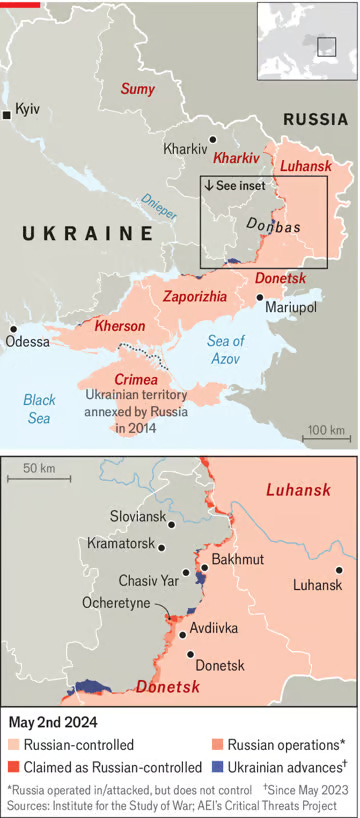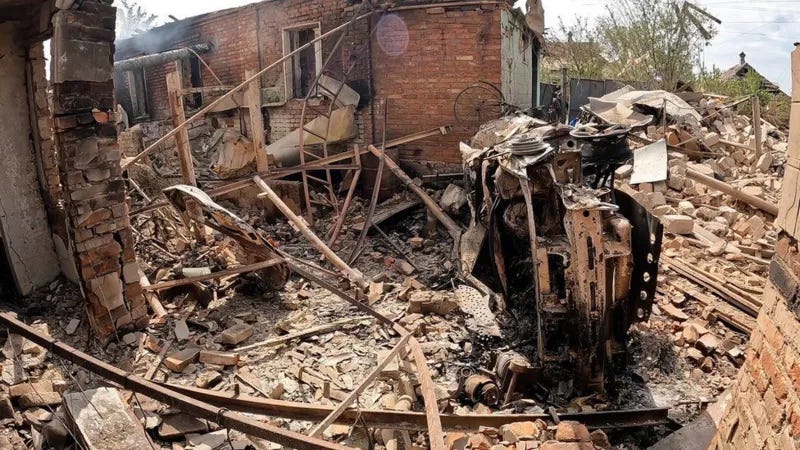Fighting for time....
What's at stake in the battle for Kharkiv
Yesterday Russian forces entered the north-eastern border town of Vovchansk, near Ukraine's second largest city Kharkiv. It is part of an offensive that began last Friday when Russian forces seized at least nine villages and settlements in one of the most significant ground attacks since its full-scale invasion of Ukraine began in February 2022.
Vovchansk has no specific military importance, but its capture takes Russian forces a step closer to their objective, Kharkiv. From there the Russians can attack south to complete the conquest of Donbas and cut off the road to Kyiv.
Thousands of civilians have fled towards Kharkiv, assisted by groups of local volunteers who have pooled a ramshackle collection of vehicles to help ferry them to reception centers in the city.
How did it come to this
A year ago, as Ukraine prepared for its counter-offensive, just holding its own positions was considered the most pessimistic scenario. Now, as Russia launches its own push, it is considered the best case. Officers and soldiers alike know that Ukraine lacks the manpower and resources to drive the Russians off its soil. “I suggest to anyone who talks of 1991 borders to come as far as Bakhmut,” said one Brigade commander publicly last week.
The Russians, are using a familiar technique – reducing Ukrainian villages and towns to rubble, before the ground assault. Over the weekend, the Russians pummeled Vovchansk with artillery– some 50-60 shells an hour by the local commander’s estimate – and glide bombs fired from aircraft up to 50 kilometers behind Russian lines. Aside from their devastating psychological effect – with engines that make a shrill scream prior to landing – glide bombs are extremely accurate. Western experts think that the main Russian glide bomb, the FA-150, is only half as accurate as Russian claims, but this leaves little room for comfort. When you are dealing with 1.5 tons of explosive, the difference between 5 and 10 meters becomes somewhat academic.
Sadly, Russia doesn’t seem to be facing a shortage of these devastating weapons - firing on average some 100 glide bombs a day across the 1,000 km front, even before the offensive began. Glide bombs are hard to intercept – fired as they are outside range of Ukrainian air defenses with a tricky attack profile.
Scene of a glide bomb attack in Vovchansk
Return to Storm Troop Tactics
Russian infantry tactics, however, have changed. Faced with weapons and surveillance systems that favor the defense, the Russians have abandoned mass attacks of the scale seen last year around Bahkmut. Instead, they appear to have adopted a very crude version of the storm troop tactics developed by the German Army in the first world war. Russian attacks now comprise small packets of infantry and armor moving towards their objective along multiple routes. In Vovchansk, the Russians first probed Ukrainian positions with small units on quad bikes or light armored vehicles supported by loitering munitions.
A Shortage of Shells
The fall of Vovchansk delivers another blow to Ukrainian morale already under pressure from a shortage of artillery shells. Fearing escalation, the West has gradually drip-fed Ukraine the weapons it needs, allowing the Russians time to adapt. Now, after a six-month gap in US supplies caused by politically motivated obstruction, the Ukrainians have enough ammunition to survive but not to drive back Russian forces. Over the last few months Ukraine has only been able to fire one artillery round to Russia’s ten. One Brigade commander from the 92nd Division told Ukrainian media last week that he was rationed to five shells a day for his US Paladin guns.
Fortunately, The US military had pre-staged much of the required ordnance in Germany to expedite delivery once the decision was made to release it. Today Secretary Anthony Blinken announced that the first ordnance would be in Ukrainian hands within a week. From a Ukrainian perspective, this comes just in time.
Gaps in the Ukrainian Line
The Kharkiv offensive also highlights problems that have plagued Ukraine throughout the war – mobilizing enough troops and building adequate defensive lines chief among them. Brigade commanders have complained for a year now that they are not receiving the support they need in building fortifications. The commander of a Ukrainian reconnaissance unit told the BBC interview yesterday that Russians appear to have simply walked into the town – through the minefields that were meant to stop them.
Not Enough Soldiers
One of the main causes of tension between President Zelensky and his top military commander Varerii Zaluszhnyl was over the military’s manpower requirements. Zaluzhny reportedly put pressure on the President to make a determined effort at general mobilization. This never happened, and now Ukraine is facing a critical manpower shortfall — with the Zelensky appealing to Ukrainian men below the age of 60 to return to their country, ‘while you still have one’. One of the many tragedies of this war is that all the men and women who were willing to defend their country signed up long ago - and many have paid the price.
What Now:
With around 50,000 fresh Russian troops closing on the city, Kharkiv’s commanders know that they must prevent the Russians from isolating the city by cutting off the main road to Kyiv. From Kharkiv the Russians can strike south and west, threatening to roll up Ukrainian forces on their left (northern) flank.
The Ukrainians have a battalion defending the high ground above Chasiv Yar, which they view as being key terrain on the approach to Kharkiv. They are rushing reinforcements to the region to reinforce Kharkiv’s defenses – and to keep the Russians beyond artillery range, just 10km away from their current positions.
Putin doesn’t need to take Kyiv to declare victory – he just needs to seize the rest of Donbas and hold on to what he has. At stake now is not Ukraine’s territorial integrity, but its survival. Slowing Russian forces in the Donbas will be critical now to this outcome.






This is great writing, Andy. Keep it up!
They did something similar in 1999 when they got to Groznyy still without very much good infantry, so they brought up the SP 420mm mortars and whenever the infantry found Chechen fighters the mortars brought the building down on them.